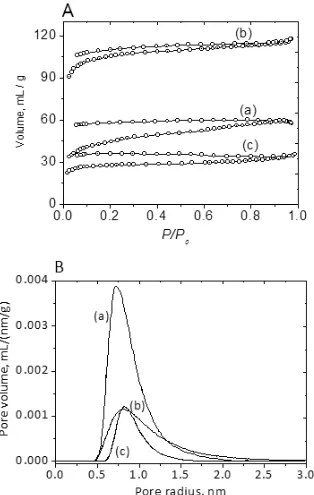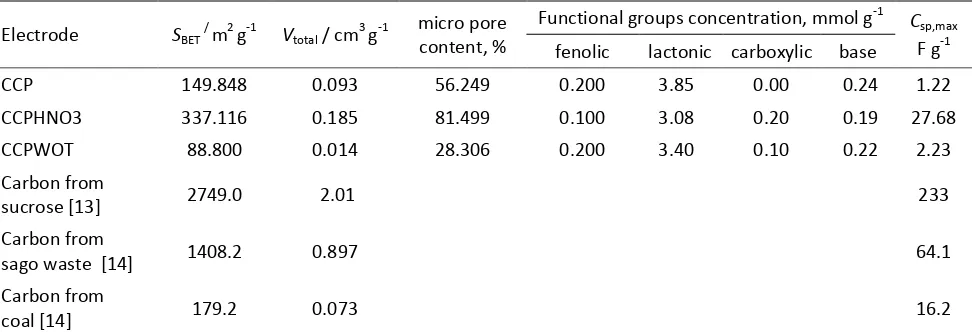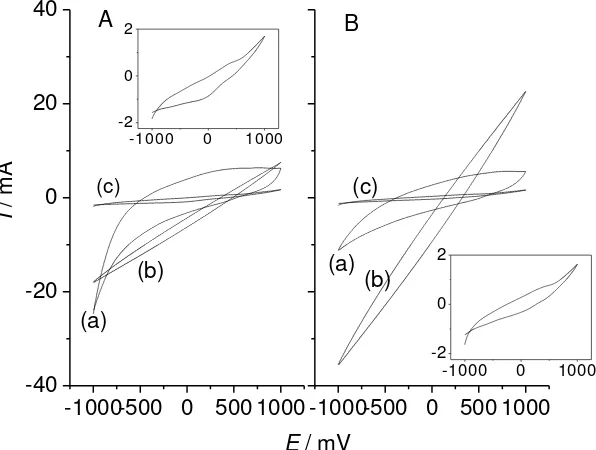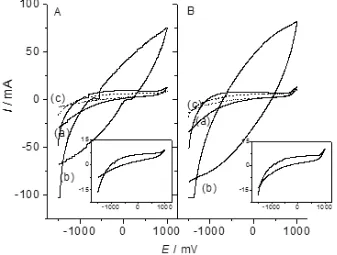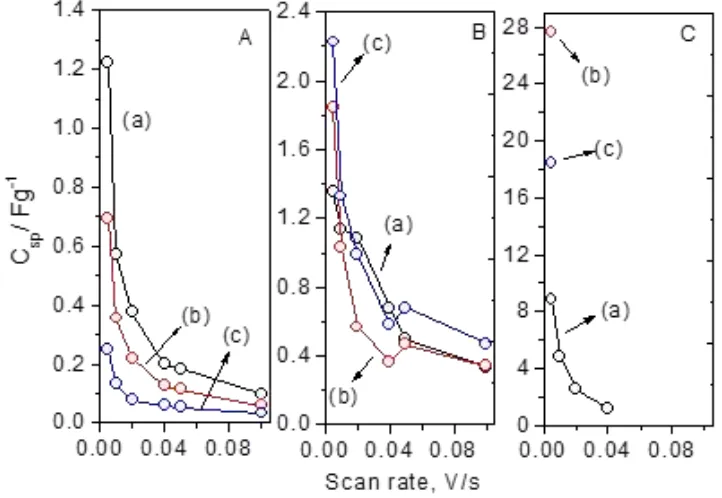J. Electrochem. Sci. Eng. 3(2) (2013) 37-45; doi: 10.5599/jese.2012.0028
Open Access : : ISSN 1847-9286
www.jESE-online.org
Original scientific paper
Binder-less activated carbon electrode from gelam wood for use
in supercapacitors
NIRWAN SYARIF*
,**
, IVANDINI A. TRIBIDASARI* and WIDAYANTI WIBOWO*
*Department of Chemistry, Faculty of Mathematics and Natural Sciences, University of Indonesia, Indonesia
**Department of Chemistry, Faculty of Mathematics and Natural Sciences, Sriwijaya University, Indonesia
Corresponding Author: E-mail: E-mail: nnsyarif@gmail.com; Tel.: +62-711-580269; Fax: +62-711-580069
Received: August 8, 2012; Revised: November 30, 2012; Published: : April 19, 2013
Abstract
This work focused on the relation between the porous structure of activated carbon and its capacitive properties. Three types of activated carbon monoliths were used as the electrodes in a half cell electrochemical system. One monolith was produced from activated carbon and considered to be a binder-less electrode. Two others were produced from acid and high pressure steam oxidized activated carbon. The micrographs clearly indicate that three electrodes have different porous structures. Both porosity and surface area of carbons increased due to the formation of grains during oxidation. This fact specified that an acid oxidized carbon monolith will have relatively higher capacitance compared to non-oxidized and steam oxidized monoliths. Maximum capacitance values for acid, steam oxidized and non-oxidized electrodes were 27.68, 2.23 and 1.20 F g-1, respectively.
Keywords
pyrolysis; voltammogram; surface oxidation; capacitance; micropore.
Introduction
also have large specific surface areas, good electrical conductivity and excellent chemical stability. The carbonaceous materials extracted from biomass such as fruit peels, beans, plant shells, bam-boo, woods, natural fibers and bagasse have been studied for supercapacitor carbon electrodes.
The fabrication of carbon electrodes for supercapacitors, normally requires an addition of a polymer matrix in order to bind together the carbon particles into monolithic (pellet) form. This addition blocks a part of the carbon pores [2] and additionally causes an increase in the electrical resistivity [3]. Furthermore, the use of polymer binder makes the product more expensive and en-vironmentally less friendly. Therefore, the carbon electrode without the use of any binding agent is highly recommended in order to be potentially used in supercapacitor applications, because they might have lower resistance in the absence of a polymeric binder and they are also of lower cost [4].
In most cases, the physicochemical properties of the carbon electrode, such as its structure, electrical conductivity and porosity, was improved by an activation process. The physical activation is normally carried out by treatment of the carbonized sample using gas atmosphere (such as CO2, N2 and water steam) under a moderately higher temperature of 800 – 1000 C to improve the internal porosity [5].
In this paper, we report the preparation and characterization of free binder activated carbon monolith electrodes prepared from Gelam wood, which were activated by physical process under N2/CO2 gas and followed by surface oxidation using nitric acid and high pressure steam. It should be emphasized that the use of this activated carbon for supercapacitor was not yet reported.
Experimental
Activated carbon and electrode preparation
Activated carbons were prepared from the gelam wood piles obtained from local timber industry. Non-bark wood piles sizes 10 cm length and 5 cm diameter was used in the production of activated carbon rod. Pyrolysis was conducted after preheating process and followed by second pyrolysis for activation process. Wood was preheated in the oven at 230 – °C for a half hour.
Wood were ar o ized y heati g fro to °C at rate of °C per i ute u der at osphere
of itroge flow a d o trolled for ½ - 1 hour at peak temperature. Nitrogen was flowed to the
reactor at rate of 1 mL min-1. The heating procedure was repeated but using CO2 as the atmosphere to produce activated carbon. This activated carbon was labeled as CCP.
CCP was cut into pellets of 5 mm in thickness by using a mini-circular electric knife. CCP was subjected for surface oxidation using concentrated nitric acid and high pressure steam, both label-ed as CCPHNO3 and CCPWOT respectively. Activatlabel-ed carbons were oxidizlabel-ed in reflux system for 3 hours using concentrated nitric acid at 60 C. The high pressure steam oxidation was conducted in the hydrothermal reactor for 16 hours at 200 C. The products were washed with abundant de-mi-neralized water and dried. These three types of activated carbon pallets were used as electrodes.
Surface characterization
The characterization of activated carbons was carried out through physical adsorption of nitrogen gas at 77 K, using a conventional volumetric system (Micromeritics ASAP 2400 instrument). The surface area based on nitrogen isotherms was calculated using the BET equation,
and usi g the t ethod. “ a i g Ele tro Mi ros opy (SEM) and Energy Dispersive X-ray
The Boehm titration method was applied to determine the acid and basic sites in the activated carbons [6]. The total acid sites were neutralized with 0.1 M NaOH solutions, and the basic sites were neutralized with a 0.1 M HCl solution. The reaction between reagents and acidic oxygenated-functional groups on the surface is based on the difference strength of the acid/base. The strength order of acidic and basic groups is as follow: carboxyl > lactone > phenol. The carboxylic and lactonic sites were titrated with a 0.1 MNa2CO3 solution, the carboxylic sites were titrated with a 0.1 M NaHCO3 solution and the phenolic sites were determined by the difference. For each determination, 50 mL of the solution was added to one gram of activated carbon in a glass container. The container was inserted into vortex shaker for over one day. A 10 mL sample was titrated with 0.1 M of HCl or NaOH solutions.
Electrochemical measurement
Electrochemical tests of the electrodes were conducted using the cyclic voltammetry technique using a three electrode configuration on a potentiostat instrument (eDAQ Pty Ltd, model EA161). Ag/AgCl electrode was used as reference electrode and a platinum rod was used as the counter electrode. Cyclic voltammetry tests were conducted at scan rates of 2, 5, 10, 20, 50, and 100 mV s -1
with potential windows ranging from -1 to 1 V in 1, 2, and 4 mol L-1 KOH or H2SO4 aqueous solution as electrolytes. Considering that the anodic voltammetric charges and cathodic voltammetric charges are not the same in the shape of voltammogram curve, the average specific capacitance of the electrode was calculated using integral area approximation
properties of electrodes. Pores act as the entrance of small molecules penetrated deeper into the micro pores [7]. Penetrating water steam and gases made some cracks and led to changed porous structures [8].
Figure 1. (A) Nitrogen adsorption-desorption on the surface of electrodes (B) Pore size distribution for (a) CCP, (b) CCPHNO3 and (c) CCPWOT.
provided to clarify the relationship between pore structure and capacitance. It can also be seen from the Table 1 that the some capacitance values obtained in this study are smaller than those obtained from the literatures.
Table 1. Surface and electrochemical properties of the CCP, CCPHNO3 and CCPWOT electrodes.
Electrode SBET amounts of functional groups, except for the carboxylic and lactone groups. A computational study was undertaken on the effect of the two functional groups on the structure of graphite basal. The study found that the COOH functional groups that fill the vertical plane will bend graphite layer led to reduced effectiveness of electron transfer between layers. These functional groups improved capacitive processes of the carbon [15], and facilitated the penetration of the electrolyte ions into the interior pores. Although the CCPWOT electrode has many more functional groups, however, many more pores were vanished and the surface area was decreased, leading to a decrease in the capacitance of electrode. Furthermore, changes in the carbon pore structure can be clearly seen as surface morphology by using electron microscope.
Figure 2. SEM images for CCP (a and d), CCPHNO3 (b and e), and CCPWOT (c and f)
Electrochemical performance
ob-The voltammogram of the CCPWOT electrode was relativelylower compared to the other two curves. Therefore the oxidation treatment under water steam reduced the capacitance. On the other hand, the highest current of CCPHNO3 electrode points to the largest capacitance. The changes in capacitance occurred on the electrode after the oxidation process was associated with changes in pore volume of carbon, as previously described. Oxidation using strong acid clarified the existence of the Faraday process (redox reaction) that occurred at the carbon as described by other authors [19]. The voltammograms shape of CCPHNO3 in both acid and base electrolytes are much the same, which means that the tendency to establish a redox reaction was similar. The voltam-mogram area in Figure 3 shows the decrease in capacitance at high concentrations of H2SO4. By contrast, the capacitance of the electrodes increased at a low concentration KOH (Figure 4).
Figure 4. Voltammogram of carbon electrodes (a) CCP, (b) CCPHNO3 and (c) CCPWOT in the KOH 2M (A) and 4M (B). Scan rate was 5mV s-1. Inset: magnification of voltammogram (c).
Calculations of specific capacitances for all electrodes at various scan rates in the H2SO4 solution are presented in Figure 5. At the 5 mV s-1 scans rate in H2SO4, the CCP electrode had a specific capacitance of 1.2 F g-1, while at a scan rate of 100 mV s-1 this was 0.22 F g-1. Capacitance values of the CCPWOT electrode (Figure 5 B) at 5 – 10 mV s-1 were lower than that of CCP (Figure 5 A), but were higher at 20 – 100 mV s-1. The capacitance values of CCP and CCPWOT electrodes were much smaller than those of the CCPHNO3 electrode (Figure 5 C). Maximum capacitance for non-oxidized, steam and acid oxidized electrodes were 1.22, 0.63 and 2.57 F g-1, respectively. These values occurred at 5 mV s-1.
was only obtained at a scan rates higher than 40 mV s-1 at 1M KOH. Capacitance value for acid and steam oxidized electrodes were 2.23 and 27.68 F g-1, respectively.
Figure 5. Plot of specific capacitance of carbon electrode (A) CCP, (B) CPPWOT and (C) CCPHNO3 versus scan rate in H2SO4(a) 4M, (b) 2M and (c) 1M.
Figure 6. Plot of specific capacitance (Csp)of carbon electrode (A) CCP, (B) CPPWOT and (C) CCPHNO3
versus scan rate in KOH (a) 4M, (b) 2M and (c) 1M.
Conclusions
The three types of electrodes, namely CCP, CCPHNO3 and CCPWOT, prepared from Gelam wood activated carbon, have different surface morphologies which basically contained many micropores. CCP has continuous - smooth surface and contains very few grain boundaries. On the other hand CCPWOT and CCPHNO3 have rough surfaces and contain many cracks. The different oxidation methods using nitric acid and water steam gave different effects on the surface area of the carbons. Acid nitric oxidation led to a larger pore volume and surface area, while water steam oxidation led the opposite effect. In addition, CCPHNO3 had relatively large amounts of micropores. The presence of surface oxides was important factor in improving the capacitance of electrode and increased the effective utilization of the pore structure. CCPHNO3 had the highest capacitance value of 27.68 F g-1 while the specific capacitance of the electrode CCPWOT was similar to CCP, at 2.23 and 1.22 F g-1, respectively.
References
[1] M. Jayalakshmi, K. Balasubramanian, Int. J. Electrochem. Sci. 3 − [2] W. Li, H. Probstle, J. Fricke, J. Non-Cryst. Solids325 −5
[3] A.G. Pandolfo, A.F. Hollenkamp, J. Power Sources157 −
[4] E. Taer, M. Deraman, I.A. Talib, A. Awitdrus, S.A. Hashmi, A.A. Umar, Int. J. Electrochem. Sci. 6 (2011) 3301 – 3315
[5] C. Merino, P. Soto, E. Vilaplana-Ortego, J.M.G.d. Salazar, F. Pico, J.M. Rojo, Carbon43
−
[6] H.P. Boehm, Carbon 32 (1994) 759-769
[7] C. Nieto-Delgado, M. Terrones, J.R. Rangel-Mendez, Biomass Bioenerg.35 − [8] S. Villar-Rodil, A. Martinez-Alonso, J.A. Pajares, J.M.D. Tascon, M. Jasienko-Hałat, E.
Broniek, J. Kaczmarczyk, A. Jankowska, A. Albiniak, T. Siemieniewska, Micropor. Mesopor. Mat.64 (2003) 11-19
[9] K.P. Gadkaree, M. Jaroniec, Carbon38 (2000) 983−
[10] K. Ramakrishnan, C. Namasivayam, Sustain. Environ. Res.19 − [11] C. Du, N. Pan, Nanotechnology17 (2006) 5314−5318
[12] R. Nickolov, D. Kovacheva, M. Mladenov, N.Velichkova, R. Raicheff, P. Tzvetkova, J. Univ. Chem. Tech. Metall.46 −
[13] K. Xia, Q. Gao, J. Jiang, J. Hu, Carbon46 (2008) 1718-1726
[14] H. Aripin, L. Lestari, D. Ismail, S. Sabchevski, Open Mat. Sci. J.4 −
[15] M.J. Bleda-Martı ez, J.A. Ma ia-Agullo, D. Lozano-Castello, E. Morallon, D. Cazorla-Amoros, A. Linares-Solano, Carbon43 (2005) 2677−2684
[16] L.L. Zhang, X. Zhao, H. Ji, M.D. Stoller, L. Lai, S. Murali, S. Mcdonnell, B. Cleveger, R.M. Wallace, R.S. Ruoff, Energy Environ. Sci.5 (2012) 9618-9625
[17] B.G. Choi, Y.S. Huh, W.H. Hong, H.J. Kim, H.S. Park, Nanoscale4 (2012) 5394-5400 [18] E. Frackowiak, F. Beguin, Carbon39 (2001) 937-950
[19] M. Seredych, D. Hulicova-Jurcakov, G.Q. Lu, T.J. Bandosz, Carbon46 (2008) 1475-1388
© by the authors; licensee IAPC, Zagreb, Croatia. This article is an open-access article distributed under the terms and conditions of the Creative Commons Attribution license
